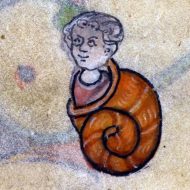Sir Gawain and the Green Knight
Week 3 online class (Friday 11 October)
Please click this link to open the document on ‘Interpreting Sir Gawain and the Green Knight’. There you will find 10 (in fact, 11) questions on the poem.
Choose ONE of the questions that particularly interests you.
Open the hypothes.is browser extension, and make sure you are in the ELIT 273 group (and NOT the ‘Public’ or ‘ELIT 227’ groups).
Part One: Write a paragraph giving your answer, or some observations triggered by the question. You are not required to give a definitive answer (in many cases this would be hard, even impossible). You should, however, support your claims with close reference to the text of the poem, giving line numbers and/or short quotations to support your argument. I suggest writing at least 200 words – it will be difficult to do justice to these questions in fewer. You should add your answer by no later than Friday 11 October at 8pm.
Part Two: Choose ONE of your fellow students’ answers, and write a response to their answer. Be polite and respectful, but look to disagree, challenge or supplement their readings, as well as drawing out their most interesting claims. Your response should be at least 75 words long. The deadline for your responses is Monday 14 October at 8pm.
Those posting satisfactory answers and responses before the deadlines will be marked as ‘present’ for Friday’s class. If you post after the deadlines, your posts may be included in your annotations grade, but you will be marked absent from Friday’s class. (Of course, you are free – and encouraged! – to post comments and responses on more than one question or answer. I will mark those engaging in meaningful, critical online conversation and debate especially generously!)
I would also encourage you to keep adding hypothes.is annotations to the poem itself – ask questions, post links, and engage with each other’s readings.
Please finish reading the poem by our Tuesday class next week.
LINKS & DOCUMENTS
Below you will find useful links and documents relating to the first poem we will be studying on this course. You will also find some things to listen to – good for your commute to class, or for revising while walking, running or stargazing.
The poem:
- J.R.R. Tolkien’s verse translation of Sir Gawain and the Green Knight. This is the edition of the poem we will be using in class. If you lose your copy, or want a copy with larger print, you can reprint it from here. I’ll say more in class about why we’ll be reading this translation. Note that you can also make hypothes.is annotations on this document.
- W. A. Neilson’s prose translation of the poem. If you prefer to read Sir Gawain and the Green Knight in prose translation, download and print this edition. Make sure you bring it to class so you can contribute to discussions and annotate your hard copy. Note you can also open this as a link and add online annotations through hypothes.is.
- Gawain in Turkish: the opening pages of Nazmi Ağıl’s translation, to help get you started. Consider buying this book to help you with the English if you are finding it difficult.
Secondary Resources & Related Texts:
- Simon Armitage introduces the poem and discusses his translation of it on the British Library website (you can also see images of the original manuscript here).
- Listen to Laura Ashe (Professor of English Literature at Worcester College, University of Oxford), Ad Putter (Professor of Medieval English Literature at the University of Bristol) and Simon Armitage (Poet and Professor of Poetry at the Universities of Leeds and Oxford, and a translator of the poem) discuss the poem with Melvyn Bragg on BBC Radio’s In Our Time radio series. (If you don’t know In Our Time already, check it out. It has wonderful discussions by leading academics on a wide range of topics and writers in English Literature, as well as on science, history, philosophy. religion and art. Look at their huge range of programmes on the Medieval period here. It’s also offers excellent models of how to talk about literature and other subjects of academic study.)
- ‘The Turk and Sir Gawain‘ – another ‘beheading’ story involving Gawain, but this time with a mysterious Turk instead of a green knight. You can read a short introduction here, before exploring the poem itself. (This is for the curious only! It is not required reading, but some of you might be interested.)
- The Camelot Project – a useful collection of information about Arthurian literature and legend, and the characters that appear within them.
- Why should we study medieval romance? – an excellent Oxford University podcast, and only 18 minutes long.
- The Three Matters of Romance – an academic website with further information
- Stanford University lecture notes on the poem
- Stanford lecture notes on the ideology of courtly love
